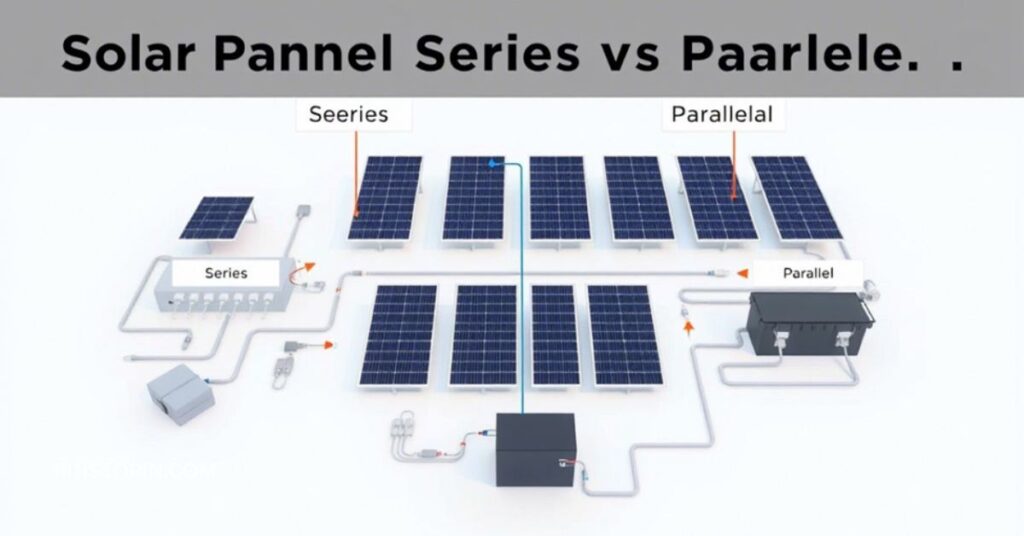I used to stare at my solar setup, confused and frustrated, wondering why my system wasn’t giving me the power I expected. I kept hearing about Solar Panel Series vs Parallel, but no one really explained it in a way that made sense. All I wanted was to get the best performance without wasting time or money. If you’re feeling the same, you’re definitely not alone.
In this post, I’ll break down the difference between solar panel series vs parallel in the simplest way possible. You’ll learn what each setup means, how they affect your power output, and which one’s better for your needs. No fancy jargon, just clear, helpful info to guide you toward the right choice for your solar system.
What Does Series and Parallel Mean in Solar Panels?
When you connect solar panels in series, it means you’re linking them end to end, like a chain. This setup adds up the voltage of each panel while the current (amps) stays the same. It’s great when you need high voltage for bigger systems.
In a parallel connection, all the positive wires go together and all the negative wires go together. This keeps the voltage the same but increases the current. It’s a smart choice when you want more power in low-light or shaded areas.
Key Differences Between Series and Parallel Configurations
- Voltage vs Current: Series increases voltage, while parallel boosts current (amps).
- Shade Impact: In series, shade on one panel can lower the whole system’s output. In parallel, other panels still work fine.
- Wiring Needs: Series needs thinner wires; parallel setups often need thicker wires to handle more current.
- System Compatibility: Series works better with MPPT charge controllers; parallel is often used with PWM controllers.
- Usage Type: Series is best for long-distance power transmission, while parallel is great for shaded or flexible setups like RVs or small homes.
Pros and Cons of Series Wiring
Series wiring is great when you need higher voltage, which can help reduce wire size and make your system more efficient. It’s simple to set up and works well with MPPT charge controllers. This setup is ideal when your panels get equal sunlight.
But there’s a downside, if one panel gets shaded or stops working, it affects the entire string. The power drops across all panels, not just the shaded one. So, it’s not the best choice for areas with lots of shadows or changing light.
Pros and Cons of Parallel Wiring
Parallel wiring is helpful when some of your solar panels might be in shade during the day. If one panel is shaded or fails, the others still work fine. It keeps your system more stable and reliable in mixed lighting conditions.
However, parallel setups need thicker wires because the current is higher. They also require more connectors and sometimes a combiner box, which can increase cost and complexity. It’s a bit more work, but worth it for better performance in shady spots.
When to Use Series Configuration
Use series configuration when your solar panels are in a spot with full, even sunlight throughout the day. It’s perfect for open rooftops or solar farms where shading is not a problem. This setup gives you higher voltage, which works well with MPPT charge controllers.
Series is also a smart choice when you need to run power over long distances. Higher voltage means lower current, so you can use thinner wires and reduce energy loss. It’s efficient, simple, and cost-effective, if shading isn’t an issue.
When to Use Parallel Configuration
Use parallel configuration when your solar panels might get partial shade at different times of the day. It’s ideal for areas with trees, chimneys, or anything that can block sunlight. In this setup, one shaded panel won’t bring down the whole system.
Parallel wiring is also a good match for PWM charge controllers and low-voltage systems. If you’re powering a small home, RV, or cabin, this setup gives you steady performance even with changing light. It offers flexibility and reliability where shading is common.
Can You Mix Series and Parallel? (Hybrid Setup)
Yes, you can mix both, this is called a series-parallel (hybrid) setup. It’s when you connect small groups of panels in series and then connect those groups together in parallel. This gives you the benefits of both higher voltage and higher current.
A hybrid setup works well in larger systems where shading is moderate and flexibility is needed. Just make sure all panel groups are balanced in size and specs. It’s a smart way to maximize performance while staying efficient and safe.
Factors to Consider Before Choosing
- Shading: If your panels may be partially shaded, go with a parallel setup for better performance.
- System Voltage: Series is best when you need higher voltage, especially for larger systems or MPPT controllers.
- Controller Type: MPPT controllers work well with series; PWM controllers are better for parallel.
- Wiring Distance: Series allows longer wire runs with less power loss and thinner cables.
- Installation Space: Parallel systems may need more components and space for extra wiring and connectors.
FAQ’s
What is the main difference between solar panel series vs parallel?
The main difference in solar panel series vs parallel is how voltage and current behave. Series increases voltage, while parallel keeps voltage steady and boosts current.
Which is better for shaded areas in solar panel series vs parallel?
In solar panel series vs parallel setups, parallel is better for shaded areas. Shade on one panel won’t affect the rest in a parallel connection.
Does solar panel series vs parallel affect battery charging?
Yes, solar panel series vs parallel wiring affects charging. Series setups charge faster with MPPT controllers, while parallel works better with PWM and partial shade.
Which uses thinner wires in solar panel series vs parallel?
In solar panel series vs parallel setups, series uses thinner wires. That’s because it runs higher voltage and lower current, reducing energy loss over distance.
Can I mix solar panel series vs parallel in one system?
Yes, you can mix solar panel series vs parallel in one hybrid system. It balances voltage and current, offering efficient power and better performance together.
Conclusion
Choosing between solar panel series vs parallel depends on your setup, sunlight conditions, and power needs. Series wiring is great for high voltage and works well with MPPT controllers, especially in full sunlight. Parallel is perfect for shaded areas and small systems using PWM controllers.
Both options have their own strengths. If you want steady performance in mixed lighting, go with parallel. For long wire runs and higher voltage, choose series. Or mix both for the best of both worlds. The right choice can save energy, time, and money.

